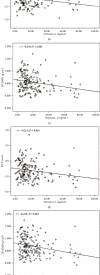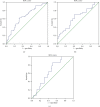Association of Circulating Omentin-1 with Osteoporosis in a Chinese Type 2 Diabetic Population
- PMID: 33149724
- PMCID: PMC7603618
- DOI: 10.1155/2020/9389720
Association of Circulating Omentin-1 with Osteoporosis in a Chinese Type 2 Diabetic Population
Abstract
Aims: Omentin-1, a newly identified adipokine, has been demonstrated to be associated with bone metabolism, but the results have been inconsistent. Moreover, the potential relationship of circulating omentin-1 with diabetic osteoporosis has never been reported. This study is intended for studying the association between circulating omentin-1, bone mineral density (BMD), prior fragility fractures, and other bone metabolic-related parameters.
Methods: Circulating omentin-1 levels were measured in 172 patients with type 2 diabetes mellitus (T2DM), and participants were divided into the normal BMD group (n = 52), the osteopenia group (n = 66), and the osteoporosis group (n = 54). The relationship between circulating omentin-1 and diabetic osteoporosis and other parameters was analyzed.
Results: Circulating omentin-1 was significantly higher in the osteoporosis group than in the normal group and in the osteopenia group (both P < 0.05). Circulating omentin-1 levels were correlated significantly and positively with sex; high-density lipoprotein cholesterol; apolipoprotein A; and prevalence of prior fragility fractures, diabetic nephropathy, and retinopathy; they were correlated negatively with diastolic blood pressure, triglyceride, hemoglobin, atherogenic index of plasma, osteoporosis self-assessment tool for Asians, BMD at different skeletal sites, and corresponding T scores, irrespective of age, sex, and body mass index (P < 0.01 or P < 0.05). Moreover, circulating omentin-1 was an independent decisive factor for the presence of osteoporosis only in women after multivariate adjustment (odds ratio: 1.069; 95% confidence interval: 1.003-1.139; P < 0.05). Lastly, the analysis of receiver operating characteristic curves revealed that the best cutoff value for circulating omentin-1 to predict diabetic osteoporosis was 15.37 ng/mL (sensitivity: 71.7%; specificity: 58.5%) in female subjects.
Conclusions: High levels of circulating omentin-1 may be associated with the development of osteoporosis in female diabetic subjects and may be a potential biomarker for diabetic osteoporosis in women.
Copyright © 2020 Pijun Yan et al.
Conflict of interest statement
No potential conflicts of interest relevant to this article were reported.
Figures



Similar articles
-
Association of circulating B-type natriuretic peptide with osteoporosis in a Chinese type 2 diabetic population.BMC Musculoskelet Disord. 2021 Mar 10;22(1):261. doi: 10.1186/s12891-021-04138-3. BMC Musculoskelet Disord. 2021. PMID: 33691659 Free PMC article.
-
Association of circulating omentin-1 level with arterial stiffness and carotid plaque in type 2 diabetes.Cardiovasc Diabetol. 2011 Nov 22;10:103. doi: 10.1186/1475-2840-10-103. Cardiovasc Diabetol. 2011. PMID: 22108456 Free PMC article.
-
Relationships between serum omentin-1 concentration and bone mineral density, and bone biochemical markers in Chinese women.Clin Chim Acta. 2013 Nov 15;426:64-7. doi: 10.1016/j.cca.2013.09.002. Epub 2013 Sep 12. Clin Chim Acta. 2013. PMID: 24036189
-
Omentin: linking metabolic syndrome and cardiovascular disease.Curr Vasc Pharmacol. 2014 Jan;12(1):136-43. doi: 10.2174/1570161112999140217095038. Curr Vasc Pharmacol. 2014. PMID: 22724476 Review.
-
Circulating apelin, chemerin and omentin levels in patients with gestational diabetes mellitus: a systematic review and meta-analysis.Lipids Health Dis. 2020 Feb 22;19(1):26. doi: 10.1186/s12944-020-01209-7. Lipids Health Dis. 2020. PMID: 32087711 Free PMC article.
Cited by
-
Relationship between serum level of miR-338-3p and miR-105-3p and bone metabolic markers in patients with diabetes nephropathy.Ren Fail. 2024 Dec;46(2):2406390. doi: 10.1080/0886022X.2024.2406390. Epub 2024 Oct 8. Ren Fail. 2024. PMID: 39378116 Free PMC article.
-
Therapeutic potential of omentin-1 in preeclampsia: enhancing fetal outcomes, vascular function, and reducing inflammation.Exp Anim. 2025 Apr 20;74(2):216-228. doi: 10.1538/expanim.24-0092. Epub 2024 Dec 7. Exp Anim. 2025. PMID: 39647913 Free PMC article.
-
The role of adipokines in osteoporosis management: a mini review.Front Endocrinol (Lausanne). 2024 Mar 6;15:1336543. doi: 10.3389/fendo.2024.1336543. eCollection 2024. Front Endocrinol (Lausanne). 2024. PMID: 38516409 Free PMC article. Review.
-
Association of serum levels of Visfatin, Intelectin-1, RARRES2 and their genetic variants with bone mineral density in postmenopausal females.Front Endocrinol (Lausanne). 2022 Nov 30;13:1024860. doi: 10.3389/fendo.2022.1024860. eCollection 2022. Front Endocrinol (Lausanne). 2022. PMID: 36531488 Free PMC article.
-
Lower Visceral Fat Area in Patients with Type 2 Diabetic Peripheral Neuropathy.Diabetes Metab Syndr Obes. 2022 Nov 21;15:3639-3654. doi: 10.2147/DMSO.S388330. eCollection 2022. Diabetes Metab Syndr Obes. 2022. PMID: 36439295 Free PMC article.
References
MeSH terms
Substances
LinkOut - more resources
Full Text Sources
Medical

